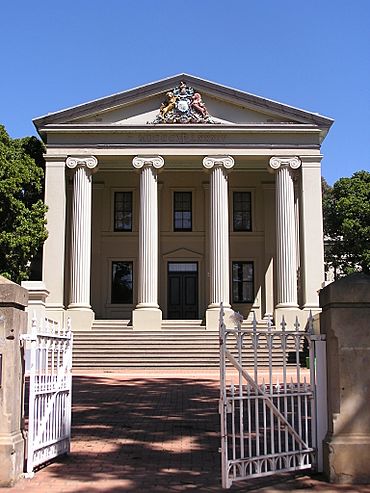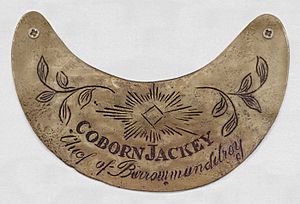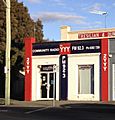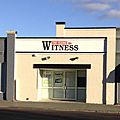Young, New South Wales facts for kids
Quick facts for kids YoungNew South Wales |
|||||||||
|---|---|---|---|---|---|---|---|---|---|

Young courthouse built in 1884 but transferred to the Department of Education in 1925 and used as the main hall of Young High School
|
|||||||||
| Population | 7,170 (2016 census) | ||||||||
| Established | 1826 | ||||||||
| Postcode(s) | 2594 | ||||||||
| Elevation | 440 m (1,444 ft) | ||||||||
| Location |
|
||||||||
| LGA(s) | Hilltops Council | ||||||||
| County | Monteagle | ||||||||
| State electorate(s) | Cootamundra | ||||||||
| Federal Division(s) | Riverina | ||||||||
|
|||||||||
Young is a town in the South West Slopes region of New South Wales, Australia and the largest town in the Hilltops Region. The "Lambing Flat" Post Office opened on 1 March 1861 and was renamed "Young" in 1863.
Young is marketed as the Cherry Capital of Australia and every year hosts the National Cherry Festival. Young is situated on the Olympic Highway and is approximately 2 hours drive from the Canberra area. It is in a valley, with surrounding hills. The town is named after Sir John Young, the governor of NSW from 1861 to 1867.
Contents
History
Before European settlers arrived in Young, members of the Burrowmunditory tribe, a family group of the Wiradjuri people, lived in the region. Descendents of the Burrowmunditory clan still live in Young.
James White was the first European settler in the district and established Burrangong Station in 1826 with a squatting claim of 260 square kilometres (100 sq mi). His story is told in the novel Brothers in Exile. Gold was found in the district in 1860. Until that time the area was called Lambing Flat, a reference to the grazing of sheep that was the main industry until mining. The town was gazetted in 1861. The goldfields produced 15,000 kilograms (470,000 ozt) of gold sent by escort from the fields. Up to 20,000 miners worked the fields including about 2,000 Chinese miners.
Lambing Flat Post Office opened on 1 March 1861 and was renamed "Young" in 1863.
From November 1860 through to June 1861, anti-Chinese miners attacked Chinese gold miners in the area, now known as the infamous Lambing Flat riots. As gold became scarce, European miners began to resent what they saw as the greater success of the more industrious Chinese, and hence many Chinese miners were attacked, robbed and killed. The anti-Chinese rebels rallied in numbers of up to 3,000. Eventually the rioters were controlled, Chinese miners had their claims restored to them, but the New South Wales Parliament passed the Chinese Immigration Bill which restricted the number of Chinese that could be brought into New South Wales on any ship and imposed a tax per head on entry.
In 1889 Young was the first town in Australia to install electricity into the streets and homes of the township, Tamworth NSW installed electricity to the streets only the previous year.
The former Young Shire was acknowledged as the first Local Government Area to institute a rural school bus system in New South Wales.
Climate
Young has a humid subtropical climate (Cfa).
| Climate data for Young Airport | |||||||||||||
|---|---|---|---|---|---|---|---|---|---|---|---|---|---|
| Month | Jan | Feb | Mar | Apr | May | Jun | Jul | Aug | Sep | Oct | Nov | Dec | Year |
| Record high °C (°F) | 42.6 (108.7) |
42.0 (107.6) |
38.6 (101.5) |
32.6 (90.7) |
25.4 (77.7) |
21.9 (71.4) |
19.9 (67.8) |
23.6 (74.5) |
26.9 (80.4) |
34.4 (93.9) |
42.1 (107.8) |
41.1 (106.0) |
42.6 (108.7) |
| Average high °C (°F) | 31.7 (89.1) |
30.4 (86.7) |
27.2 (81.0) |
22.7 (72.9) |
17.8 (64.0) |
13.9 (57.0) |
12.9 (55.2) |
14.6 (58.3) |
17.8 (64.0) |
21.9 (71.4) |
26.1 (79.0) |
29.1 (84.4) |
22.2 (72.0) |
| Average low °C (°F) | 14.6 (58.3) |
14.7 (58.5) |
11.1 (52.0) |
6.6 (43.9) |
3.3 (37.9) |
2.4 (36.3) |
1.1 (34.0) |
1.3 (34.3) |
3.1 (37.6) |
5.3 (41.5) |
9.3 (48.7) |
11.8 (53.2) |
7.0 (44.6) |
| Record low °C (°F) | 1.4 (34.5) |
2.3 (36.1) |
0.4 (32.7) |
−4.1 (24.6) |
−5.8 (21.6) |
−6.1 (21.0) |
−6.4 (20.5) |
−6.5 (20.3) |
−5.5 (22.1) |
−4.7 (23.5) |
−2.4 (27.7) |
−0.2 (31.6) |
−6.5 (20.3) |
| Average precipitation mm (inches) | 41.0 (1.61) |
51.4 (2.02) |
46.2 (1.82) |
31.5 (1.24) |
40.0 (1.57) |
64.1 (2.52) |
60.9 (2.40) |
51.0 (2.01) |
54.4 (2.14) |
45.9 (1.81) |
64.0 (2.52) |
57.8 (2.28) |
589.7 (23.22) |
| Average precipitation days | 6.7 | 7.3 | 6.9 | 5.7 | 9.6 | 14.9 | 17.5 | 14.7 | 11.6 | 9.1 | 8.5 | 7.1 | 119.6 |
Demographics
On 2016 census night, 9 August 2016, there were 7,170 people (3,385 males and 3,783 females) counted in Young. There were 367 people (5.1%) (197 males and 172 females) who identified as being of Indigenous origin. The median age of people was 40 years.
The number of people born overseas in the 2016 Census was 1023 (13.9%) compared with 650 (5.8%) in the 2001 Census, 589 (5.3%) in the 1996 Census and 549 (5.1%) in the 1991 Census. Of those born overseas, the three main countries of birth in the 2016 Census were:
- England: 95 (1.3%)
- New Zealand: 47 (0.7%) and;
- Lebanon: 37 (0.5%).
In the 2016 Census, the three most common ancestries identified with were:
- Australian: 3405 people (35.8%)
- English: 2957 people (31.1%) and;
- Irish: 1045 people (11.0%).
English was stated as the only language spoken at home by 6,413 people (89.6%) in the 2016 Census. The three most common languages spoken at home other than English in the 2016 Census were:
- Arabic (including Lebanese): 88 (1.2%)
- Tagalog: 22 (0.3%) and;
- Mandarin: 22 (0.3%).
In the week preceding the 2016 Census, 1894 households (67.8%) had accessed the internet at home. 501 (8.9%) people held a bachelor's degree or above. 212 people were unemployed, representing 7.6% of the labour force. The median weekly individual income for people aged 15 years and over in the 2016 Census was $505. In the 2016 Census, there were 2,324 separate houses (83.2%), 202 semi-detached, row or terrace houses and townhouses (7.2%), 257 flats, units or apartments (9.2%) and 3 other dwellings (0.1%). In the 2016 Census, there were 594 couple families with children (which comprised 34.4% of all families in occupied private dwellings), 675 couple families without children (39.1%), 431 one parent families (24.9%) and 28 other families (1.6%).
The Lambing Flat Chinese Tribute Gardens
Young Shire Council has established these gardens adjacent to the site of Chinamans Dam, which is an old railway dam about 4 km south of Young. They are intended to create an ambience similar to the Japanese Gardens at Cowra. Chinamans Dam, with an initial capacity of over 9,100 cubic metres (2×106 imp gal) when it was in railway use, is situated at a very small place called Pitstone on Sawpit Gully. The story goes that the dam was built in the 1860s by Dutch brothers, Herman and John Tiedemann, to provide water for the sluicing of their Victoria Hill gold claims. At some time in the 1870s, the brothers sold the area, including the dam, to a Chinese group who worked the site.
The story of the dam as a railway facility began in 1882 when the NSW Railway Commissioners gave notice of the intention to build the first part of the Blayney-Demondrille railway. To provide water for its steam locomotives, the Commissioners decided to provide a dam and pump water from it to a facility, known as Young Tank, at the 396-kilometre (246 mi) post. It is not known whether the railways enhanced the existing dam or built a new facility.
From 1885 to 1901, locomotives stopped at Young Tank to replenish their water. In 1901, watering facilities were built at Young Station. The supply of water was obtained from Chinamans Dam. The capacity of the dam was enlarged in 1911.
The dam was a popular spot for swimming. Whilst officially frowned upon, it was tolerated.
Following the connection to the South West Tablelands Water Supply Scheme, which provided water from Burrinjuck Dam, the railways ceased to draw water from Chinamans Dam after 1936. The site was returned to the Crown in 1962 and in the following year, a 15-hectare (36-acre) reserve was established and the Shire Council appointed as Trustees. The dam has since been enlarged.
Notable people
- Charles Anderson VC, MC (1897–1988), a Member of Parliament
- Donald Chalmers AO, Chief of Navy from 1997 to 1999
- Thomas Collins (1884–1945), a Member of Parliament
- Rose Ann Creal, matron, recipient of the Royal Red Cross (First Class)
- Peter Cusack, a rugby league footballer
- Libby Gleeson, a children's author
- Bert Hopkins, an Australian cricketer
- Ron Lynch, a rugby league footballer and coach
- Nathan Lyon, an Australian cricketer
- Roger McDonald, an author
- Kerry Saxby-Junna, double Commonwealth Games gold medal racewalker
Sport
The town's rugby league team competed for the Maher Cup.
- Young Yabbies is a rugby union team playing in the Southern Inland Rugby Union competition.
- Young Cherrypickers is a rugby league team playing in the Group 9 competition
- Young Saints is an Australian football team playing in the Central West AFL competition.
- Young Lions is a soccer club fielding teams that play in the Bathurst District Soccer Senior Men's and Senior Women's competition.
Education
Young has six schools:
- St Mary's Primary School
- New Madinah College
- Young North Primary School
- Young Public School
- Hennessy Catholic College
- Young High School
Images for kids















